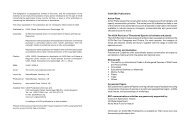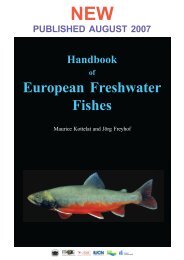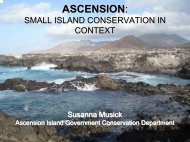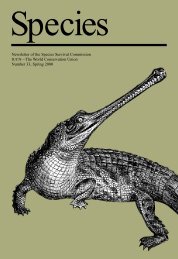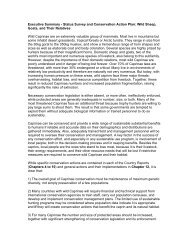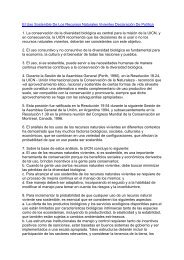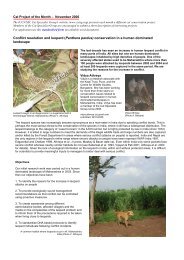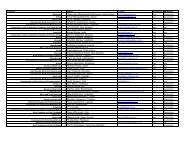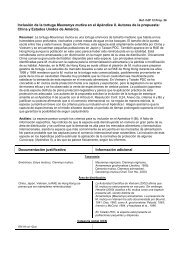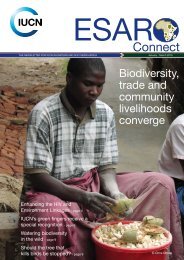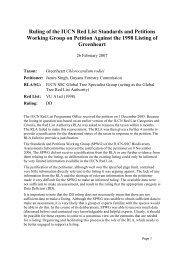Planning education to care for the earth - IUCN Knowledge Network
Planning education to care for the earth - IUCN Knowledge Network
Planning education to care for the earth - IUCN Knowledge Network
You also want an ePaper? Increase the reach of your titles
YUMPU automatically turns print PDFs into web optimized ePapers that Google loves.
<strong>Planning</strong> <strong>education</strong> <strong>to</strong> <strong>care</strong> <strong>for</strong> <strong>the</strong> <strong>earth</strong>community discourages poaching and enhances <strong>the</strong> spirit of sharing. Thesemoves reflect <strong>the</strong> idea that <strong>the</strong> best hope <strong>for</strong> <strong>the</strong> long-term conservation ofspecies and eco-systems is found in satisfying legitimate human needs by <strong>the</strong>sustainable use of natural renewable resources.In contrast with past practice, CAMPFIRE gives local people <strong>the</strong> opportunity<strong>to</strong> make in<strong>for</strong>med decisions on projects <strong>to</strong> implement. Needs pinpointed in<strong>the</strong> wards and villages taking part in <strong>the</strong> programme are seriously consideredby District Councils. There is a reciprocal consultation which givesCAMPFIRE educative value; this is a process through which projects thatwork are promoted and those that do not are discarded.Training of cadres at village, ward and district levels is an important featureof CAMPFIRE. These cadres - community workers, moni<strong>to</strong>rs, problemanimal reporters, guards and professional hunters - are elected, and <strong>the</strong>irresponsibilities are determined by <strong>the</strong> local people. Rural development gainsfrom this <strong>for</strong>m of transparency and accountability.There are training inputs from local people, with outsiders as facilita<strong>to</strong>rs.This relationship helps <strong>to</strong> bridge <strong>the</strong> gap between trainer and trainees and ismutually rein<strong>for</strong>cing. Most training has elements of book keeping (basicincome/expenditure relationships), project planning and implementation(how <strong>to</strong> establish priorities, assess risks and benefits), moni<strong>to</strong>ring andevaluation (communities have a better sense of <strong>the</strong> social aspects than donoror implementing agencies), and meeting procedures.Partners in CAMPFIRECAMPFIRE is an adaptive rural development programme with several partnersassuming different responsibilities in <strong>the</strong> CAMPFIRE Collaborative Group.Zimbabwe Trust is involved in developing institution-building capacities, <strong>the</strong>Centre <strong>for</strong> Applied Social Sciences undertakes baseline social surveys andtraining <strong>for</strong> moni<strong>to</strong>ring, and <strong>the</strong> World Wide Fund <strong>for</strong> Nature carries outecological surveys. The Department of National Parks and Wildlife Training isconcerned with technical and policy training, and <strong>the</strong> Africa Resources Trust isinterested in international linkages. Action Magazine is involved inenvironmental curriculum development. The Ministry of Local Government,Rural and Urban Development provides basic policy guidelines on ruraldevelopment through Rural District Councils.This multi-faceted, multiple-accountable programme in which <strong>the</strong> drivecomes from <strong>the</strong> rural people and in which outside agencies are catalysts,called <strong>for</strong> an umbrella organization <strong>to</strong> link local demands with national andinternational networks. The CAMPFIRE Association was <strong>for</strong>med in 1989and given a secretariat in 1991. The association’s CAMPFIRE Newsletterenables local people <strong>to</strong> disseminate <strong>the</strong>ir know-how. Communities sendarticles <strong>for</strong> publication in <strong>the</strong> newsletter, which serves as an effectivecommunication link at all levels. The association encourages research anddocumentation and represents local communities in Zimbabwe atinternational meetings.70



